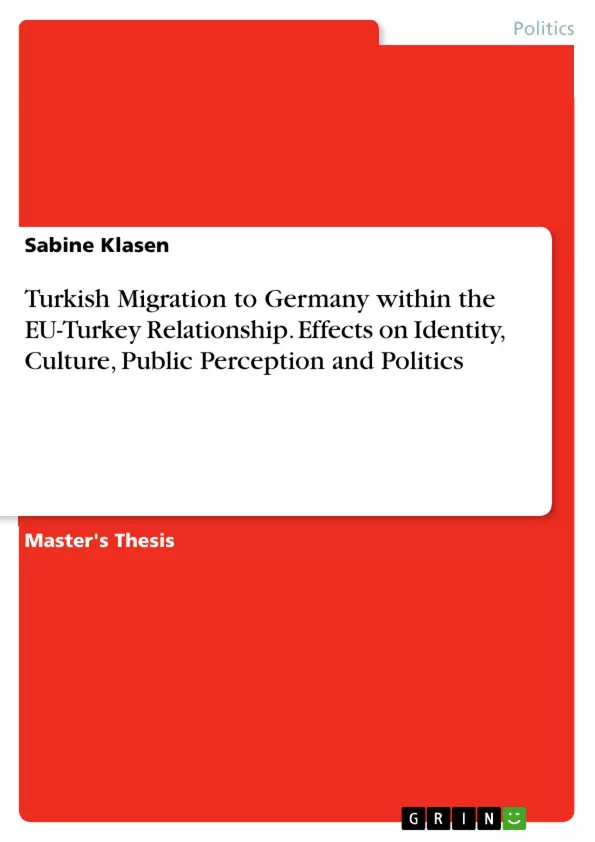Within the German-Turkish relationship, this thesis focusses particularly on the aspect of migration from Turkey to Germany, its motivations, implications and structures within the process of Turkey’s potential future membership of the EU.
The aim of the thesis is to provide an overview of the current situation and relationship between Turkey and Germany, which arise from past and current migration flows and connections between the two countries. These findings together with an analysis of the development and status quo of Turkey’s relationship with the EU as a whole are subsequently trying to figure out Germany’s position and influence on the EU accession process. In order to deliver a profound and specialised piece of research within a limited scope, the thesis is focussing on issues of migration and integration as well as human rights as contentious factors concerning Turkey’s EU accession.
Finally, it is trying to give an outlook on further developments, chances and challenges for all sides. It is thereby only marginally regarding other important matters such as geopolitical and economic relations that have to be considered for a holistic assessment of the Turkey-Germany/EU relations. The paper intends to increase the reader’s consciousness and knowledge about the German impact and position in Turkey’s way to an EU accession, while presupposing a reader that is conversant with the subject and the history of the Turkey and the EU.
Inhaltsverzeichnis (Table of Contents)
- Introduction
- Hypothesis
- State of research
- Aim of the thesis
- Migration structures between Turkey and Germany
- Migration and integration theories
- Historical migration relationship
- Integration in Germany
- Turkish culture and identity in Germany
- Religious, cultural and geographical issues as tensioning factors
- Initiatives for (cultural) integration
- Turkey and the European Union - Quo vadis?
- Historical development
- Status Quo
- Present obstacles
- Migration and human rights issues
- Germany's special position within the EU accession process
- Role of Germany's Turkish community
- Role of religion, culture and (European) identity in the public debate
- Role of the German media
- Role of German politics
- Possible migration effects on Germany of a Turkish EU accession
Zielsetzung und Themenschwerpunkte (Objectives and Key Themes)
This thesis aims to provide a comprehensive understanding of the complex relationship between Turkey and Germany, with a particular focus on migration from Turkey to Germany and its impact on Turkey's potential accession to the European Union. It examines the historical and contemporary migration structures between the two countries, analyzes the integration experiences of Turkish migrants in Germany, and explores the role of German politics, media, and society in shaping the EU accession process.
- Migration and integration processes between Turkey and Germany
- The impact of Turkish migration on Germany's political and social landscape
- The role of Germany in the EU accession process for Turkey
- The dynamics of cultural and religious identity in the context of integration
- The influence of the German media and political landscape on the perception of Turkish accession
Zusammenfassung der Kapitel (Chapter Summaries)
- Introduction: This chapter introduces the thesis' hypothesis, research context, and aim. It highlights the importance of Turkish migration to Germany and its potential influence on Turkey's EU accession process.
- Migration structures between Turkey and Germany: This chapter explores the historical migration relationship between Turkey and Germany, delves into various migration and integration theories, and examines the integration experiences of Turkish migrants in Germany. It examines the social, cultural, and political dynamics of integration.
- Turkey and the European Union - Quo vadis?: This chapter analyzes the historical development of Turkey's relationship with the EU, discusses the current status of negotiations, and highlights the existing obstacles and challenges. It explores the complexities of Turkey's EU accession process and the potential implications for both sides.
- Germany's special position within the EU accession process: This chapter focuses on the role of Germany in the EU accession process for Turkey. It examines the influence of the German Turkish community, the impact of cultural and religious issues, the role of the German media, and the stance of German politics. It explores how Germany's position on Turkey's accession impacts the EU's overall strategy.
Schlüsselwörter (Keywords)
This thesis primarily focuses on the themes of Turkish migration, integration, cultural identity, EU accession process, German politics, media and society, and the complex relationship between Turkey and Germany.
- Arbeit zitieren
- Sabine Klasen (Autor:in), 2015, Turkish Migration to Germany within the EU-Turkey Relationship. Effects on Identity, Culture, Public Perception and Politics, München, GRIN Verlag, https://www.grin.com/document/309337



